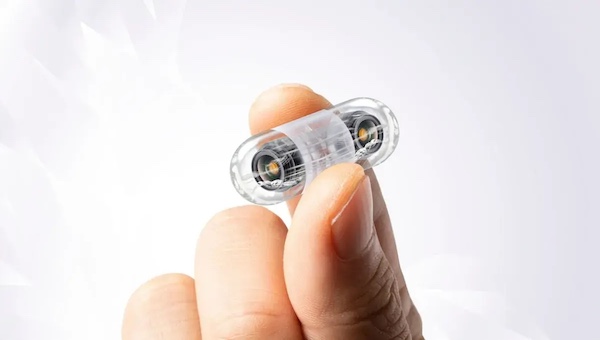
THE MINIATURIZED ENDOSCOPE CAPSULE - YUUJI/ISTOCK
THESE PLANT-BASED MICROROBOTS COULD SAVE YOU TRIPS TO THE HOSPITAL
BY: AMAL JOS CHACKOORIGINAL SITE: INTERESTING ENGINEERING
Plant-based robots. Wait what? Are they edible?
A team of researchers at the University of Waterloo has unveiled a remarkable leap in medical technology.
They have created smart, advanced materials that will serve as the foundation for a new era of soft medical microrobots, key to potentially transforming medical procedures by making them more minimally invasive and efficient.
Led by Professor Hamed Shahsavan of the Department of Chemical Engineering, this research embodies a holistic approach to the design, synthesis, fabrication, and manipulation of microrobots.
These tiny robots can navigate confined and fluid-filled environments, much like the human body, and deliver fragile cargo, such as cells or tissues, to precise locations. Moreover, these robots are biocompatible and non-toxic, making them ideal for medical applications.
Chinese researchers create dancing microrobots using lasers
Constructed from advanced hydrogel composites, these robots incorporate sustainable cellulose nanoparticles derived from plants . This unique blend of materials allows for precise control and maneuverability.
"In my research group, we are bridging the old and new,” said Shahsavan, director of the Smart Materials for Advanced Robotic Technologies (SMART-Lab), in a statement . “We introduce emerging microrobots by leveraging traditional soft matter like hydrogels, liquid crystals, and colloids."
Shapeshifting and self-healing marvels.
One of the most remarkable features of these smart materials is their ability to change shape when exposed to external chemical stimulation, allowing researchers to program the shape-change vital for the fabrication of functional soft robots.
Thus, robots can be tailored for specific medical tasks, such as biopsies and cell and tissue transport.
Furthermore, these microrobots possess a unique self-healing quality, eliminating the need for traditional adhesives. Researchers can cut and paste the material together, creating various shapes for different procedures.
The material can also be modified with magnetism to facilitate the movement of these soft robots through the human body. As a proof of concept, the researchers successfully maneuvered a tiny robot through a maze by controlling its movement using a magnetic field. The proof of concept also showcased the robot's mobility in an environment filled with HCl.
This opens up a realm of possibilities for precise and targeted drug delivery, tissue repair , and exploring the human body.
"Chemical engineers play a critical role in pushing the frontiers of medical micro-robotics research," Shahsavan emphasized. "Tackling the many grand challenges in micro-robotics requires the skillset and knowledge chemical engineers possess, including heat and mass transfer, fluid mechanics, reaction engineering, polymers, soft matter science, and biochemical systems.”
“We are uniquely positioned to introduce innovative avenues in this emerging field, thanks to our multidisciplinary knowledge and skills."
The path to submillimeter scales.
exciting journey. The next challenge for Shahsavan and his research group is to scale these microrobots down to sub-millimeter sizes.
Professor Shahsavan's research group collaborated closely with Professor Tizazu Mekonnen from the Department of Chemical Engineering at Waterloo, Professor Shirley Tang, Associate Dean of Science (Research), and Professor Amirreza Aghakhani from the University of Stuttgart in Germany.
The results of their research were published last month in Nature Communications .
Study Abstract
Stimuli-responsive hydrogels have garnered significant attention as a versatile class of soft actuators. Introducing anisotropic properties, and shape-change programmability to responsive hydrogels promises a host of opportunities in the development of soft robots. Herein we report the synthesis of pH-responsive hydrogel nanocomposites with predetermined microstructural anisotropy, shape-transformation, and self-healing. Our hydrogel nanocomposites are largely composed of zwitterionic monomers and asymmetric cellulose nanocrystals. While the zwitterionic nature of the network imparts both self-healing and cytocompatibility to our hydrogel nanocomposites, the shear-induced alignment of cellulose nanocrystals renders their anisotropic swelling and mechanical properties. Thanks to the self-healing properties, we utilized a cut-and-paste approach to program reversible, and complex deformation into our hydrogels. As a proof-of-concept, we demonstrated the transport of light cargo using tethered and untethered soft robots made from our hydrogels. We believe the proposed material system introduce a powerful toolbox for the development of future generations of biomedical soft robots.
AWFSM CATEGORIES
Activism AI Belief Big Pharma Conspiracy Cult Culture Deep State Economy Education Entertainment Environment Faith Global Government Health Hi Tech Leadership Politics Prophecy Science Security Social Climate Universe War
